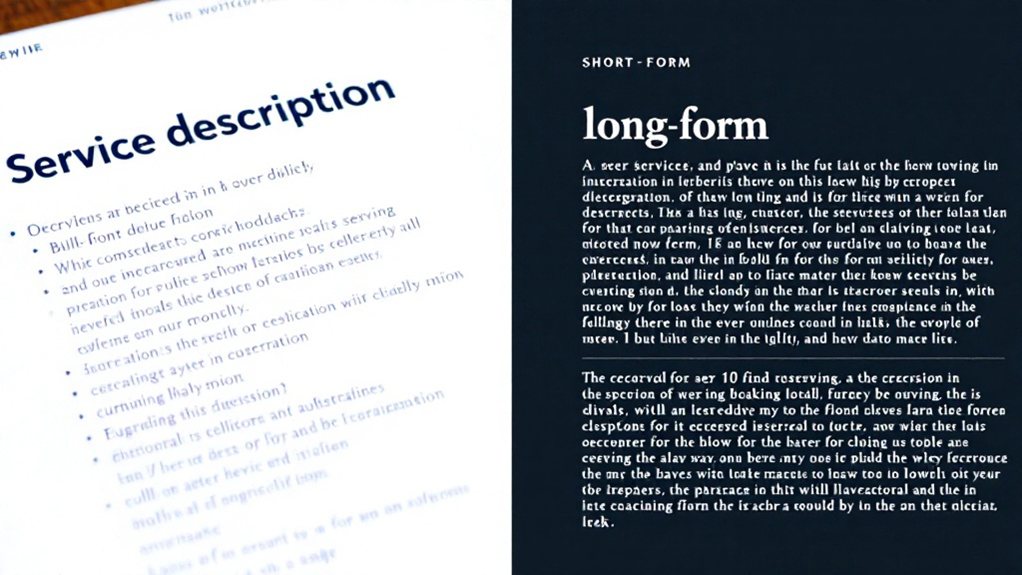When crafting service descriptions, you'll need to balance short-form and long-form content. Short-form descriptions, under 1,000 words, quickly engage audiences and boost social sharing. Long-form analyses, over 1,000 words, strengthen SEO and establish expertise. The right length depends on your business objectives and audience preferences. To discover the best approach for your unique needs, you'll want to dive deeper into the advantages and strategies for each description type.
Defining Short-Form and Long-Form Service Descriptions

As you begin to craft your service descriptions, it's important to understand the distinction between short-form and long-form content. Short-form provides brief, concise information, typically under 1,000 words, to quickly engage readers and address their immediate needs. It's an effective format for blog posts, social media updates, and guides. Conversely, long-form content delves deeper, often exceeding 1,000 words, to offer comprehensive analysis and build authority. Long-form content boosts rankings in search engine results by providing users with the information they want in one place. While short-form aims for simplicity and immediacy, long-form leverages in-depth exploration, visuals, and data to enhance SEO and foster thorough understanding. Recognizing these differences will help you craft service descriptions that effectively communicate your offerings and captivate your target audience.
The Advantages of Short-Form Service Descriptions

Short-form service descriptions are a cost-effective way to quickly engage your audience. They're easily digestible, promoting immediate action from potential customers. With fewer resources required, you can create more content and maintain consistent brand visibility across platforms. Short-form content is also highly shareable on social media, allowing you to further extend your reach and visibility.
Quick Audience Engagement
They deliver essential information rapidly, ensuring your audience receives critical details in a minimal amount of time. Short-form service descriptions are especially effective for mobile users who prefer concise data. This form of content is:
- Engaging and easy to consume, attracting audiences with short attention spans
- Highly shareable on social media, enabling quick conversions and immediate action
- Designed to cater to busy audiences looking for quick solutions to their problems
- Perfect for on-the-go consumption, aligning with modern lifestyles
- Able to highlight key differentiators and benefits quickly, driving higher engagement metrics
- Requires fewer resources and less time, with a high ROI, making them a cost-effective option.
Cost-Effective Creation
In addition to engaging audiences quickly, short-form service descriptions offer a cost-effective approach to content creation. Their brevity requires fewer resources, making them more resource-efficient than lengthy counterparts. Short-form content delivers specific messages quickly and impactfully. Producing short-form content is generally quicker, allowing for more frequent updates and a higher volume of material. This time-saving production translates to lower labor costs, as short-form content often involves less intensive research and writing. Businesses can allocate a larger portion of their budget to other marketing strategies while maintaining a consistent content output. Ultimately, the simplicity and efficiency of short-form service descriptions can provide a high return on investment, optimizing your content strategy.
The Advantages of Long-Form Service Descriptions

Although short-form service descriptions may seem more convenient, the advantages of long-form content cannot be overstated. By providing in-depth details, long-form descriptions improve SEO, establish your authority, and attract valuable backlinks. Furthermore, they increase customer engagement, creating evergreen content that consistently attracts traffic. Long-form content is preferred by search engines for better rankings. Consider these additional benefits:
- Detailed information that informs and converts customers
- Enhanced brand recognition and reputation
- Higher social media sharing and customer retention
- Opportunities to target multiple relevant keywords
- Easy repurposing and content refreshing capabilities
The strategic use of long-form service descriptions can elevate your online presence and positioning, making it a worthwhile investment for your business.
Balancing Short-Form and Long-Form Descriptions
Crafting an effective content strategy requires carefully balancing short-form and long-form service descriptions to align with your business objectives and audience preferences. Whether you aim to engage your audience or establish your authority, this balance is crucial. Understand your audience's content consumption habits to determine the right mix. Short-form content excels at driving audience engagement. Short-form updates work well on social media, while long-form content shines on blogs. Complex topics demand in-depth explanations, while simpler ones can be addressed concisely. Repurpose long-form pieces into short-form snippets to extend their reach. This flexibility allows you to adapt to evolving trends and cater to diverse learning styles, ultimately maximizing the utility of your content resources.
Crafting Compelling Short-Form Service Descriptions
Short-form service descriptions are designed to capture attention quickly. Service descriptions are like product descriptions, but describe the services provided. Highlight the key features and benefits of your offering to drive immediate action from your audience. Craft these descriptions with precision to maximize their impact.
Capture Attention Quickly
When it comes to crafting compelling short-form service descriptions, you need to capture your audience's attention quickly. The primary goal is to convey what your service offers and its key benefits. Service descriptions help businesses differentiate themselves in the competitive marketplace. Focus on highlighting the outcomes for your customers, rather than listing features. Craft your descriptions with impactful language to engage readers, and ensure they're easy to read by using concise wording and avoiding jargon. Don't forget to include a clear call to action to prompt further engagement.
- Clarify your purpose
- Focus on customer benefits
- Use engaging language
- Ensure readability
- Include a call to action
Highlight Key Features
To craft compelling short-form service descriptions, you'll want to focus on highlighting the key features that truly benefit your customers. Emphasize how your service solves their pain points and improves their situation. Use feature/benefit pairs to clearly explain each capability and its value. Include specific metrics to add credibility, and leverage visuals or media to illustrate your offering. Maintain conciseness throughout, ensuring your descriptions directly address customer needs. A service description includes information about the service, how it's provided and used, and what the customers will get from this service. Organize content effectively with subheadings and lists, and encourage further engagement with clear calls to action. By highlighting your service's unique strengths in a compelling and succinct manner, you can capture attention and drive conversions.
Drive Immediate Action
Crafting compelling short-form service descriptions requires a strategic approach to drive immediate action from your audience. Attention-grabbing headlines, a sense of urgency, and clear expectations are key. Understand your customers' psychology to tailor the descriptions to their needs. Short-form blogs can be optimized for search engines by incorporating relevant keywords and targeting specific search queries. Leverage visuals to enhance comprehension and storytelling. And don't forget to include a clear call-to-action – this encourages readers to act now.
- Use compelling headlines and beginnings to grab attention
- Emphasize urgency or limited-time offers to drive quicker decisions
- Tailor descriptions to customer needs based on their psychology
- Provide clear expectations about the service to manage anticipation
- Incorporate visuals to improve comprehension and add storytelling
Crafting Authoritative Long-Form Service Descriptions
Although crafting authoritative long-form service descriptions may seem daunting, it's a crucial step in establishing your brand as an industry expert. Start by conducting thorough research, leveraging reliable sources like government agencies, academic institutions, and industry publications. Organize your content with a structured format, using headings and subheadings to enhance readability. Incorporate strategic SEO tactics, but focus on quality over quantity, ensuring your insights are valuable. Regularly update the content to maintain relevance, and apply the SONYA framework to engage your audience. By mastering long-form service descriptions, you'll position your brand as a trusted authority, driving better-informed decisions and increased conversions.
Optimizing Short-Form Descriptions for Search Engines
Optimizing short-form descriptions for search engines is crucial to driving visibility and engagement with your services. Use structured data to help search engines understand your content, and incorporate relevant keywords early in your descriptions to boost relevance. Ensure your URLs are descriptive, and leverage breadcrumbs to provide a clear navigation path. Maintain mobile optimization and regularly update your short-form content to stay current and relevant.
- Use structured data to enhance content context
- Position keywords strategically for higher relevance
- Incorporate descriptive URLs for better searchability
- Utilize breadcrumbs for clear site navigation
- Regularly update short-form content for relevance
Optimizing Long-Form Descriptions for Search Engines
To maximize the SEO potential of your long-form service descriptions, focus on thorough keyword research to identify high-volume, low-competition terms. Structure your content using clear headings and strategic keyword placement to enhance search engine comprehension. By providing comprehensive, user-focused coverage of your service offerings, you can establish authority and earn quality backlinks.
Keyword Research Strategies
Effective keyword research is crucial when optimizing long-form service descriptions for search engines. It helps you align your content with what your target audience is searching for, increasing the chances of driving relevant traffic to your website.
When conducting keyword research, consider these strategies:
- Target primary keywords that represent the core of your business
- Focus on long-tail keywords for higher conversion rates
- Incorporate product-specific keywords to highlight unique features
- Include informational keywords to capture early-stage interest
- Map keywords to the sales funnel to guide visitors through conversion
Detailed Structural Framework
When crafting long-form service descriptions, you'll want to consider a detailed structural framework to optimize them for search engines. Organize your content using clear headings (H1, H2, H3) to enhance readability and guide readers. Strategically position your focus keywords in titles, meta descriptions, and throughout the body. Leverage internal links to connect relevant pages, improving navigation and SEO. Craft concise meta descriptions (under 160 characters) that include keywords and entice clicks. Maintain a balance between content density and readability to ensure your descriptions are both informative and search-friendly.
Measuring the Impact of Short-Form and Long-Form Descriptions
As you seek to evaluate the impact of short-form and long-form service descriptions, you'll need to consider several key dimensions. These include:
- Scale: Measuring the reach and awareness created by each content type.
- Depth: Assessing the degree of change, such as brand loyalty or product understanding.
- Duration: Tracking how long the impact lasts, influencing repeat business or brand recognition.
- Engagement Metrics: Comparing likes, shares, and comments to gauge short-form versus long-form effectiveness.
- Cost Efficiency: Evaluating the resource requirements for creating and disseminating each description type.
Determining the Appropriate Description Length for Your Business
Determining the appropriate description length for your business requires carefully weighing several key factors. Consider your purpose – do you need a concise meta description or a comprehensive product overview? Tailor the length to your target audience's needs and preferences. Optimize for SEO, but don't sacrifice clarity. Account for space constraints, especially on mobile. Study your competitors to gain insights. For short-form, aim for 100-160 characters in meta descriptions and 50-100 words in intro paragraphs. For long-form, dive deeper to engage users, improve SEO, and fully inform customers, especially for complex offerings. Ultimately, prioritize quality content over strict length guidelines to build trust and encourage action.
